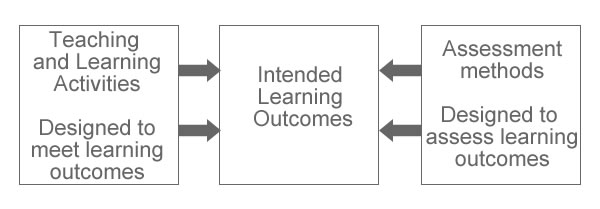How do I align learning methods and assessment for a course?
Getting started
 Orientation
Orientation
- What does alignment actually mean?
- How do I know that I have aligned the elements in my course?
Alignment Practice
Satisfactory performance in the design and planning of a courses and programmes might achieved through showing that you have clear learning outcomes that are aligned with the learning methods and the assessment(s) for a course(s). The concept of alignment has been covered in How do I plan my teaching? If you have not looked at the section on alignment you might want to visit it now.
In summary, alignment ensures that the teaching and learning activities are of a sort that will enable students to achieve the intended learning outcomes and that the assessment methods are designed to assess the learning outcomes. In other words, alignment is about consistency.
The following will serve as an example of alignment.
Learning outcome: Students will be able to obtain clear, comprehensive and relevant case histories.
Teaching activities: Lecture on obtaining clear, comprehensive and relevant case histories; tutorial on obtaining clear, comprehensive and relevant case histories; clinical skills sessions in which students are paired to practice obtaining clear, comprehensive and relevant case histories; and supervised session with patient to practice obtaining clear, comprehensive and relevant case histories.
Assessment: Students are assessed on their ability to obtain clear, comprehensive and relevant case histories.
In this example the activities are of a sort that will enable students to achieve the intended learning outcome. Achievement consists of mastering a particular skill to a particular standard. The assessment must require students to demonstrate the skill at the desired standard.

Our example specified particular teaching and learning activities. However, there are a range of activities that can be used to help your students achieve intended learning outcomes includes:
- lectures;
- tutorials;
- clinical or work placement;
- small group activities;
- setting students collaborative learning exercises, or
- engaging students in online tasks.
We describe some of the key features of effective assessments in Delivery of teaching to facilitate learning. The key point in this section is that assessment methods need to align with the intended learning outcomes and the teaching and learning activities.
The steps involved in the alignment of course learning outcomes, methods and assessments can be summarised as follows:
- Define the intended learning outcomes;
- Choose teaching and learning activities that are likely to lead to the achievement of the intended learning outcomes; and
- Develop assessments that require students to demonstrate their achievement to the specified standard of learning expressed in the assessment criteria.
 Action
Action
Achieving a satisfactory performance in the Design and Planning of Courses and Programmes might be evidenced by showing that you are able to write clear learning outcomes that are supported by appropriately chosen learning methods aligned with assessment.
- If you're familiar with how to write learning outcomes and with the theory of alignment you might want to start an ePortfolio record to evidence your activity in this area.
- You'll need to start you work in this area with a particular course/teaching activity; this will probably be a course/teacing activity that has presented you with some challenges e.g. students may not be grasping the necessary concepts or skills or students may be performing poorly in the assessment.
Taking it further

| Biggs, J. (2008). Aligning Teaching for Constructing Learning. Focus, 16(1), 1-3. |
Teaching and learning take place in a whole system, which embraces classroom, departmental and institutional levels. A poor system is one in which the components are not integrated, and are not tuned to support high-level learning. In such a system, only the ‘academic' students use higher-order learning processes. In a good system, all aspects of teaching and assessment are tuned to support high level learning, so that all students are encouraged to use higher-order learning processes. ‘Constructive alignment' (CA) is such a system. It is an approach to classroom and curriculum design that optimizes the conditions for quality learning.
| Biggs, J.B. (1996). Enhancing Teaching Through Constructive Alignment. Higher Education, 32(3), 347-364. |
Two lines of thinking are becoming increasingly important in higher educational practice. The first derives from constructivist learning theory, and the second from the instructional design literature. Constructivism comprises a family of theories but all have in common the centrality of the learner's activities in creating meaning. These and related ideas have important implications for teaching and assessment. Instructional designers for their part have emphasised alignment between the objectives of a course or unit and the targets for assessing student performance. Constructive alignment represents a marriage of the two ways of thinking,constructivism being used as a framework to guide decision-making at all stages in instructional design: in deriving curriculum objectives in terms of performances that represent a suitably high cognitive level, in deciding teaching/learning activities judged to elicit those performances, and to assess and summatively report student performance. The performances of understanding nominated in the objectives are thus used to systematically align the teaching methods and the assessment. The process is illustrated with reference to a professional development unit in educational psychology for teachers, but the model may be generalized to most units or programs in higher education.
| Spencer, J. (2003). ABC of Learning and Teaching in Medicine: Learning and Teaching in the Clinical Environment. BMJ, 326(7389), 591-594. |
This is a very useful article if you want an overview of effective teaching practices in a clinical setting.
Add to myEportfolio
| If you need to log in: FMHS staff - log in with NetID/UPI. Registration is not required. Affiliated members, e.g. clinical teachers who don't have NetID, can register for an account after clicking 'Login'. | ||||
 |  | |||
 How do I align learning methods and assessment for a course?
How do I align learning methods and assessment for a course?
“A teaching philosophy can help you to reflect on how and why you teach. If you don’t have a teaching philosophy, you might want to consider writing one. You can take a look at What makes a good teacher? to get started. If you already have a teaching philosophy, you might want to reflect on how the work that you are doing here fits with that philosophy”.
| « How do I write clear learning outcomes for a course? | How can I gather feedback and act on what I find? » |




